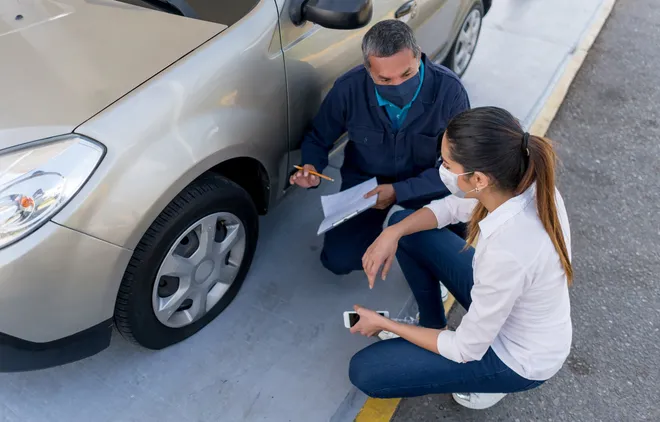Eggs and housing costs have been some of the inflationary hot buttons around the nation for the past year or so. Auto insurance also can be added to the list.
Drivers are now paying $2,014 a year on average, according to a Bankrate.com study that examined comprehensive policies (which cover risks in addition to collisions such as vandalism and windshield damage). Based on what Americans earn, that was equivalent to a 2.9% bite out of the average U.S. household income. Insurance premiums rose 13.7% nationally over the past year, according to the study.
Rising costs have been even more noticeable in certain areas, such as Orlando, where premiums rose 22.6% on average over the past year, and metro Phoenix, up 17.3%, the study said. Motorists in places including the Miami and Tampa areas are now paying more than 5% of their incomes on average for insurance premiums, and only slightly better in Detroit at 4.8%, according to the report.
Cheaper car insurance compared with incomes
By comparison, auto insurance is highly affordable relative to incomes in and around Boston, Seattle and Washington, D.C. — each between 1.3% and 1.5% or so — according to the study by Bankrate.com.
Just like you might shop around more for food or an apartment, this can be a good time to receive a few more auto-insurance quotes if you haven’t done so lately, especially if your driving patterns, credit scores or other factors have changed.
“There’s no downside to shopping around,” said Cate Deventer, a Bankrate auto-insurance analyst.
Inflation drives higher insurance costs
Inflation is a primary culprit in escalating prices or premiums for auto coverage, with costs rising for mechanics, other types of labor, repair parts and more. “Really, the numbers come down to inflation,” Deventer said.
She thinks more premium hikes could be in the works, as insurers are requesting higher rates from state insurance departments that reflect price levels in 2022 when inflation was a bit higher than it is currently.
Higher wages are being paid to mechanics, warehouse workers, drivers who deliver parts to repair shops, and to people in many other roles. Rising labor costs are spread over “everything from the creation and installation of that bumper to the paint that is being applied to it,” said Jeff LaScala, an independent insurance agent and president of the Coverage Pro in Sun City West, Arizona.
Rising accident claims affect car insurance premiums, too
Auto insurance premiums are, of course, also affected by the frequency and severity of claims. While the long-term trend has been favorable in many respects, collisions are on an upswing again after a pandemic slowdown when many workers didn’t need to commute to their jobs.
“After decades of decline, traffic deaths have increased in the past several years due to riskier driving behaviors —more speeding, driving under the influence, not wearing seat belts, distracted driving,” reads a commentary by the Insurance Information Institute.
In 2021, U.S. traffic deaths reached a 16-year high, with nearly 43,000 deaths, the group said, citing statistics from the National Highway Traffic Safety Administration.
With collisions rising, supplies still trying to catch up and more sophisticated and expensive parts going into each vehicle, repair costs also are on the upswing, LaScala said. Even the sensors in the windshield system might require microchips and calibration, he added.
Catalytic converter thefts climb
And there are emerging repair issues, such as the trend of more thefts of catalytic converters, based on their precious-metals content. With the right tools, two experienced thieves can steal a converter in less than two minutes, LaScala said. The thieves might receive only $25 to $100 to sell a converter to a scrap yard, while motorists might need to spend $1,100 or more to replace one, he added.
Against that backdrop, auto insurers apparently misjudged the effects of the pandemic and its aftermath. When accidents initially ebbed early in the pandemic, they returned $14 billion in refunds and account credits to customers, according to the Insurance Information Institute. But losses now exceed pre-pandemic levels and premiums likely will need to keep climbing “significantly” in years to come, the organization predicts.
Causing an accident could boost your insurance premium. So would adding a teen driver to your policy. Even a notable decline in your credit score could be harmful. Most states allow insurers to use credit scores in setting premiums, as drivers with lower scores are more statistically likely to submit claims, according to the Bankrate study. In general, premiums nationally for people with poor credit scores were nearly double those of drivers with excellent credit, the report said.
California, Hawaii and Massachusetts are among the few states that restrict the use of credit in setting auto premiums, according to Bankrate. Nevada has instituted a temporary ban on the practice.
How to lower your premium
But several factors also can lead to lower premiums, which can make comparison shopping worthwhile. The Insurance Information Institute suggests getting quotes from at least three insurers.
Also, you might be able to cut your premium by reducing coverage on older vehicles that might not be worth as much as you think. Among other cost-saving suggestions, you might want to seek a low-mileage discount if you don’t drive much, install an anti-theft device, check premium costs before purchasing a certain vehicle and bundle your homeowners and auto insurance policies with the same company.
And if you can afford to pay a bit more for repairs directly, consider raising your deductible from, say, $200 to $500 or even $1,000. Those increases could result in reduced premiums of at least 15% and as much as 40% or so for collision and comprehensive policies, the institute said.
Insurers reward good drivers with lower premiums. If you’re willing to demonstrate your driving patterns, consider looking for discounts tied to various telematic devices, Deventer suggested.

